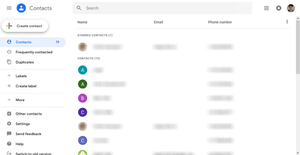Google Contacts
Google Contacts is Google's contact management tool that is available in its free email service Gmail, as a standalone service, and as a part of Google's business-oriented suite of web apps G Suite.
 The web version of Google Contacts | |
| Developer(s) | |
|---|---|
| Initial release | March 3, 2015 |
| Stable release | 3.16.1.290725621
/ January 23, 2020 |
| Operating system | Android, Web browser |
| Type | Contact management |
| Website | contacts |
Features
- Optional sorting of contacts into groups and arrangement by first or last name.
- Contacts can be provided in many categories with information.
- Extensive search function.
- Changes to contacts are automatically saved.
- Ability to restore the entire database from a time within the last 30 days.
- Easily find and merge duplicates.
- Keyboard shortcuts for simplified handling.
- Integration with other Google products.
Interoperation
Google Contacts can be synchronized with mobile devices and operating systems (e.g., Android, Symbian, iOS, BlackBerry, Palm, Pocket PC, or Windows Phone) or with PC applications (e.g., Microsoft Outlook or Mozilla Thunderbird) via third-party software, and Google's own Google Sync app. In addition, any system that can sync via Microsoft's ActiveSync can sync with Google Contacts.[1] There is also support for mobile devices that support the Microsoft® Exchange ActiveSync® protocol and/or the SyncML standard. There is built-in support for Google Contacts in Google's open-source mobile operating system Google Android.[2] Google Contacts can be synchronized also by CardDAV.
Import/Export
Google Contacts can be utilized by the user specifically, using any of three CSV (Comma-separated values) file methods listed below:
1) Google CSV format (for importing into a Google account).
2) Outlook CSV format (for importing into Outlook or another application).
3) vCard format (for importing into Apple Address Book or another application).
The user can choose to Import/Export to a file, contained outside of the "Interoperation" mode listed above, by choosing the "More" menu item on most of the Google Services webpages displaying the Contacts List. The user may then choose to use the file as a hard backup, or edit this file in a text editor, database, or spreadsheet for external or momentary use. This data may then be imported back into the Interoperation Services with the same dynamics being applied: with logistics such as "duplicates" at the point in time of synchronization.
Criticism
With the introduction of higher-density screens and larger internal memories to Android devices, the Google Contacts system was criticized for supporting only low-resolution photos, with size limited by 96x96 pixels.[3][4] This issue was fixed on October 10, 2012 on devices with 'Jelly Bean' to a higher limit of 720x720 pixels.[5]
As of 22 January 2017, G Suite users still couldn't use high-resolution contact photos, unless the so-called new version of Google Contacts was enabled on their account.[6]
See also
- List of personal information managers
- Google Sync
- Gmail
- Outlook People
- Contacts (Mac OS)
References
- "Syncing contacts". Google, Inc. Retrieved 8 August 2011.
- "Nexus One - Contacts" (Video). Google, Inc. 4 January 2010. Retrieved 8 August 2011.
- "Issue 3870: Poor quality of contact images". Retrieved 18 September 2011.
- "Jelly Bean Bumps Contact Photos To Hi-Res 720x720". Retrieved 18 September 2011.
- "Hallelujah: Google Finally Fixes High Resolution Contact Sync, Updates Web Contact Sync With Brand New UI". Retrieved 15 February 2013.
- "G Suite Update Alerts: Enable the new Google Contacts for your users from the Admin console". Gsuiteupdates.googleblog.com. 2016-03-29. Retrieved 2017-01-22.